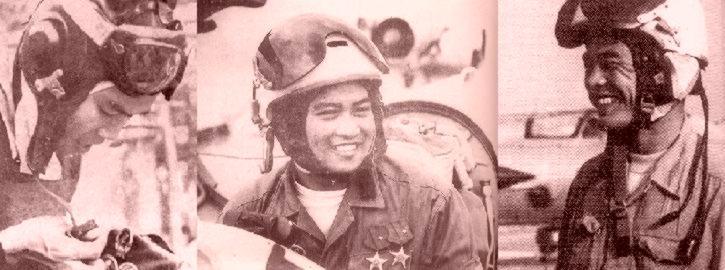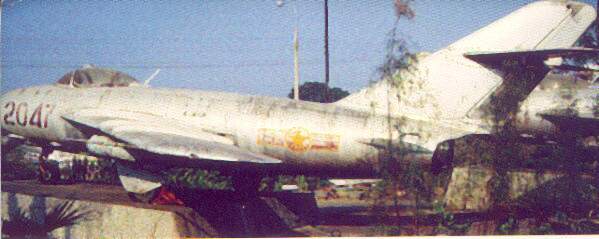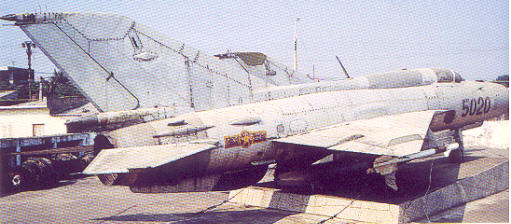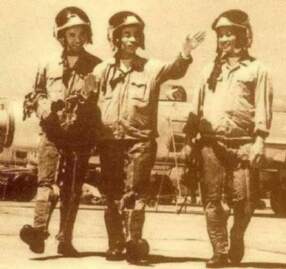North Vietnamese Aces
MiG-17 and MiG-21 pilots, Phantom and "Thud" Killers
By Diego Zampini, Nov. 2002. Updated March 22, 2012.
August 23 1967, 14:00. Another US raid against the capital of North Vietnam is in process.
Due to the size of the American formation (40 aircraft, including Thunderchiefs carrying bombs, F-105Fs ready to supress the SAM radars, and escorting Phantoms) the crew of one of those F-4Ds, Charles R. Tyler (pilot) and Ronald M. Sittner (WSO), of the 555th TFS/8th TFW, felt overconfident. They did not expect any MiGs, which had been inactive after several bloody defeats dealt them by the Phantoms of the 8th TFW in late May and early June.
Suddenly, Tyler heard on the radio an F-105D pilot (Elmo Baker) announcing that he had been hit by a MiG-21 and was ejecting. As Tyler looked for the unexpected bandit, a tremendous explosion shook his plane, and Tyler lost control of his aircraft, and bailed out. Hanging in his parachute he saw his F-4D falling in flames to the jungle, but he did not see his WSO eject; Sittner had been killed instantly by the missile hit. Both Tyler and Baker were captured by North Vietnamese troops as soon as they touched the ground.
Both had been shot down by R-3S Atoll missiles fired by two MiG-21PF Fishbeds of the 921st Fighter Regiment of the Quan Chung Khong Quan (Vietnamese People's Air Force, VPAF) flown by Nguyen Nhat Chieu and Nguyen Van Coc. Two more F-4Ds fell that day, without any MiGs lost, one of the VPAF's most successful days.
While only two American pilots became aces in the Vietnam War - Randy "Duke" Cunningham (USN) and Steve Ritchie (USAF) - sixteen Vietnamese pilots earned that honor. Nguyen Van Coc is also the Top Ace of Vietnam War with 9 kills: 7 planes and 2 UAV (Un-manned Airborne Vehicle) Firebees. Among those seven US planes, six are confirmed by US records (see table below), and we should add to this figure a confirmed USAF loss (the F-102A flown by Wallace Wiggins (KIA) on February 3 1968), originally considered a probable by the VPAF. Even omitting UAV "drones," his 7 confirmed kills qualified Coc as the Top Ace of the war, because no American pilot achieved more than 5.

Why so many Vietnamese Aces?
Why did so many VPAF pilots score higher than their American adversaries? Mainly because of the numbers. In 1965 the VPAF had only 36 MiG-17s and a similar number of qualified pilots, which increased to 180 MiGs and 72 pilots by 1968. Those brave six dozen pilots confronted about 200 F-4s of the 8th, 35th and 366th TFW, about 140 Thunderchiefs of the 355th and 388th TFW, and about 100 USN aircraft (F-8s, A-4s and F-4s) which operated from the carriers on "Yankee Station" in the Gulf of Tonkin, plus scores of other support aircraft (EB-6Bs jamming, HH-53s rescuing downed pilots, Skyraiders covering them, etc).
Considering such odds, it is clear why some Vietnamese pilots scored more than the Americans; the VPAF pilots simply were busier than their US counterparts, and they "flew till they died." They had no rotation home after 100 combat sorties because they were already home. American pilots generally finished a tour of duty and rotated home for training, command, or flight test assignments. Some requested for a second combat tour, but they were the exceptions.

North Vietnamese pilots run towards their MiG-17s to take off and engage US aircraft.
What about the tactics of both sides? Because the USAF did not attack the main radar installations and command centers (it worried about killing Russian or Chinese advisers), the Vietnamese flew their interceptors with superb guidance from ground controllers, who positioned the MiGs in perfect ambush battle stations. The MIGs made fast and devastating attacks against US formations from several directions (usually the MiG-17s performed head-on attacks and the MiG-21s attacked from the rear). After shooting down a few American planes and forcing some of the F-105s to drop their bombs prematurely, the MiGs did not wait for retaliation, but disengaged rapidly. This "guerrilla warfare in the air" proved very successful.
Such tactics were sometimes helped by weird American practices. For example, in late 1966 the F-105 formations used to fly every day at the same time in the same flight paths and used the same callsigns over and over again. The North Vietnamese realized that and took the chance: in December 1966 the MiG-21 pilots of the 921st FR intercepted the "Thuds" before they met the escorting F-4s, downing 14 F-105s without any losses. That ended on January 2 1967 when Col. Robin Olds executed Operation "Bolo."

Vietnamese ground personnel prepare two MiG-21PF for combat.
What about training? In mid-1960's the American pilots were focused on the use of air-to-air missiles (like the radar homing AIM-7 Sparrow and IR AIM-9) to win the air battles. However, they had forgotten that a skillful pilot in the cockpit was as important as the weapons he uses. The VPAF knew that, and trained its pilots to exploit the superb agility of the MiG-17, MiG-19 and MiG-21 - getting into close combat, where the heavy Phantoms and "Thuds" were at a disadvantage. Only in 1972, when the "Top Gun" program improved the skills in aerial combat of USN Phantom pilots like Randall Cunningham, and the F-4E appeared with a 20 mm built-in Vulcan cannon, could the Americans neutralize that Vietnamese edge.
Finally,
the overwhelming US numerical superiority meant that, from the point of
view of
the Vietnamese pilots, the aerial
battlefield was a "target rich environment." For the American airmen
Vietnam was a "target poor environment." The Americans could not find
enough enemy aircraft to pile up large scores simply because there
weren't that many MiGs around;
the VPAF never had more than 200 combat aircraft.
All these factors created more Vietnamese aces than American, and created opportunities for a few Vietnamese aces to pile up bigger scores than their American counterparts. Officially, there were 16 VPAF Aces during Vietnam War (13 were MiG-21 pilots, and three were MiG-17 drivers, there were no MiG-19 aces). The number in parentheses indicates the kills confirmed by US sources; they could be increased in the future. The list includes all the Vietnamese credited as aces.
VPAF MiG-17 and MiG-21 Aces of the Vietnam War
| Top Vietnamese Aces | Kills (*) | Comments | Unit | Plane |
| Nguyen Van Coc | 9 (7) | 2 F-4Ds, 1 F-4B, 2 F-105Fs, 1 F-105D and 1 F-102A | 921 FR | MiG-21PF |
| Nguyen Hong Nhi | 8 (3) | 1 UAV, 1 F-4D, 1 F-105D. Downed once | 921 FR | MiG-21 |
| Pham Thanh Ngan | 8 (1) | 1 RF-101C | 921 FR | MiG-21F-13 |
| Mai Van Cuong | 8 (?) | - | 921 FR | MiG-21 |
| Dang Ngoc Ngu | 7 (1) | 1 F-4C on May 22 1967 | 921 FR | MiG-21 |
| 7 (5) | 2 F-8s, 1 F-4B, 1 A-4C and 1 F-105D | 923 FR | MiG-17F | |
| 6 (5) | 3 F-4Es, 1 F-4J, 1 A-7B | 927 FR | MiG-21PFM | |
| Nguyen Ngoc Do | 6 (2) | 1 F-105F, 1 RF-101C | 921 FR | MiG-21 |
| Nguyen Nhat Chieu | 6 (2) | 1 F-4 (w/MiG-17), 1 F-105D | 921 FR | MiG-17 & MiG-21 |
| Vu Ngoc Dinh | 6 (5) | 3 F-105Ds, 1 F-4D, 1 HH-53C | 921 FR | MiG-21 |
| Le Thanh Dao | 6 (2) | 1 F-4D, 1 F-4J | 927 FR | MiG-21PFM |
| Nguyen Danh Kinh | 6 (3) | 1 F-105D, 1 EB-66C, 1 UAV | 921 FR | MiG-21 |
| Nguyen Tien Sam | 6 (1) | 1 F-4E | 927 FR | MiG-21PFM |
| Le Hai | 6 (2) | 1 F-4C, 1 F-4B | 923 FR | MiG-17F |
| Luu Huy Chao | 6 (1) | 1 RC-47 606 ACS | 923 FR | MiG-17F |
| Nguyen Van Nghia | 5 (1) | - | 927 FR | MiG-21PFM |
| (*) The number in parenthesis indicate how many of the claims match with US losses reported so far. | ||||

VPAF Aces. From left to right: Nguyen Van Bay (7 kills), Nguyen Van Coc (9) and Nguyen Doc Soat (6).
Here are some accounts of deeds performed by those valiant pilots who faced the most powerful air force in the world in defense of their homeland, and who earned the respect of their enemies, the American airmen.
What about Colonel Toon?
Readers familiar with American military aviation may have heard of the legendary Vietnamese ace, Col. Toon (or Col. Tomb). Why is he not listed here? Because, he was precisely that, "legendary." No Col. Toon ever flew for the VPAF; he was a figment of the American fighter pilots' imagination and ready room chatter. (In fairness to the Americans, "Col. Toon" may have been shorthand for any good Vietnamese pilot, like any solo nighttime nuisance bomber in WW2 was called "Washing Machine Charlie.")
Nguyen Van Bay
When the 923rd Fighter Regiment was created on September 7 1965, Nguyen Van Bay was one of the students chosen to fly the MiG-17F Frescos. His training ended in January 1966, and soon the young Lt. Bay saw action against American aircraft.
On June 21 1966 four MiG-17s of the 923rd FR engaged an RF-8A recce plane and its escorting F-8 Crusaders of VF-211. Even as the escorting Crusaders destroyed two MiGs, Nguyen Van Bay opened his score when he bagged the F-8E of Cole Black, who ejected and became a POW. Even more important, the Vietnamese People's Air Force pilots achieved their main goal; as Bay and his buddies distracted the escort, Phan Thanh Trung in the lead MiG shot down the RF-8A. The pilot, Leonard Eastman, was also taken prisoner.
A week later -June 29- Bay and three more MiG-17 pilots engaged American F-105Ds heading for the fuel depots in Hanoi, North Vietnam and (together with Phan Van Tuc) Nguyen Van Bay surprised and shot down a "Thud." His victim, the leader of the US formation, turned out to be Major James H. Kasler, a Sabre Ace during the Korean War with 6 MiG kills.

MiG-17F '#2047,' in the VPAF Museum in Hanoi.
Nguyen Van Bay flew this plane when he damaged the destroyer USS
Oklahoma City on April 19
1972.
However, his greatest deed happened on April 24 1967. Now a flight leader, Bay scrambled from Kien An airfield and led his flight of MiG-17Fs against a USN raid on the Haiphong docks. Bay closed on an unaware F-8C of VF-24 and fired a burst of deathly 37 mm shells which broke it into pieces. The F-8C -BuNo 146915, piloted by Lt. Cdr. E.J.Tucker- caught fire and crashed. Tucker ejected and was captured (unfortunately he died in captivity). The escorting F-4Bs of VF-114 entered the battle and fired several Sidewinders against Bay, but Bay's wingman -Nguyen The Hon- warned him, and Bay sharply broke off, evading all the missiles. Bay then headed his MiG-17 Fresco towards one of the Phantoms and shot it down with cannon fire (The crew, Lt. Cdr. C.E. Southwick and Ens. J.W. Land, was recovered. They thought they had been downed by AAA). The next day, April 25, his flight of MiG-17s scored again, shooting down two A-4s with no losses themselves. Both kills are confirmed by the US Navy: the first victim was the A-4C BuNo 147799 piloted by Lt. C.D. Stackhouse (POW), who fell under the guns of Bay's MiG-17, and the second was the A-4C BuNo 151102, piloted by Lt(jg) A.R. Crebo, who was rescued. Bay was awarded the Hero's Medal of the Vietnamese People's Army for his outstanding skill and bravery in combat, and for his superb leadership of his flight. In early 1972 this Vietnamese MiG ace and his buddy Le Xuan Di were trained by a Cuban advisor in anti-ship warfare, and they certainly were good students, because on April 19 1972 they attacked the destroyers USS Oklahoma City and Highbee, which were shelling targets in Vinh city. While Bay caused only slight damage to the first one, Le Xuan Di hit one of the Highbee stern turrets with a 500 pound BETAB-250 bomb - the first air strike suffered by the USN 7th Fleet since the end of WW2.
Nguyen Doc Soat
One of the merits of the Vietnamese People's Air Force was that the more successful pilots could transfer their combat experience to the novice students. That was the case of Nguyen Doc Soat. Originally this young MiG-21 student was assigned to the 921st FR, and his instructors were the hottest VPAF pilots of the outfit: Pham Thanh Ngan (8 kills) and the top Vietnamese ace, Nguyen Van Coc (9 victories). Soat couldn't ask for better teachers. While he did not score kills at that time, he gained valuable experience.
Re-assigned to the recently created 927th Fighter Regiment, when Operation "Linebacker I" began in May 1972, Soat was ready to show his abilities. On the 23rd he scored his first victory, downing a USN A-7B Corsair II with 30 mm fire. His victim was Charles Barnett (KIA).
On June 24 1972 two MiG-21s flown by Nguyen Duc Nhu and Ha Vinh Thanh took off from Noi Bai at 15:12 to intercept some Phantoms attacking a factory in Thai Nguyen, North Vietnam. The American escort reacted rapidly and headed towards them. But those MiGs were actually only a bait; suddenly two MiG-21PFMs of the 927th FR appeared, piloted by Nguyen Doc Soat (leader) and Ngo Duy Thu (wingman), who took the escorting F-4Es by surprise. Firing a heat-seeking missile R-3S Atoll, Soat downed the F-4E of David Grant and William Beekman, both crewmen became POWs, as Thu also did with another Phantom.

Nguyen Doc Soat scored some of his F-4 kills while flying the MiG-21PFM Fishbed '5020'.
Three days later Soat and Thu scrambled from Noi Bai at 11:53 and headed towards four F-4s, but knowing that eight more Phantoms were incoming, they did not risk being "sandwiched" by the arriving US fighters. They turned back, climbed to 5,000 mts (15,000 feet) and waited. Their patience was rewarded, and surprised the trailing pair of F-4s, and both Soat and Thu bagged one Phantom each with R-3 missiles. Soat's victim was one F-4E, and the crew (Miller/McDow) was captured.
On August 26 1972, Nguyen Doc Soat had the distinction of shooting down the only USMC Phantom downed in air combat during the Vietnam War. The RIO of the downed F-4J was rescued, but the unfortunate pilot -Sam Cordova- died. The Vietnamese MiG ace scored his last victory on October 12, when he blasted out of the sky the F-4E of Myron Young and Cecil Brunson (both POW).
Along with Nguyen Van Coc and other VPAF vets, Soat is a living legend in the country for which he bravely and skillfully fought 30 years ago.
S. Sherman & Diego Fernando Zampini
Sources and recoomended links:
-
Air War over North Vietnam, Dr. Itsvan Toperczer, Squadron/Signal Publications Inc. 1998.
-
MiG-21 Units of the Vietnam War, Istvan Toperczer, 2001, Osprey Military
-
MiG-17/19 Units of the Vietnam War, Istvan Toperczer, 2001, Osprey Military

